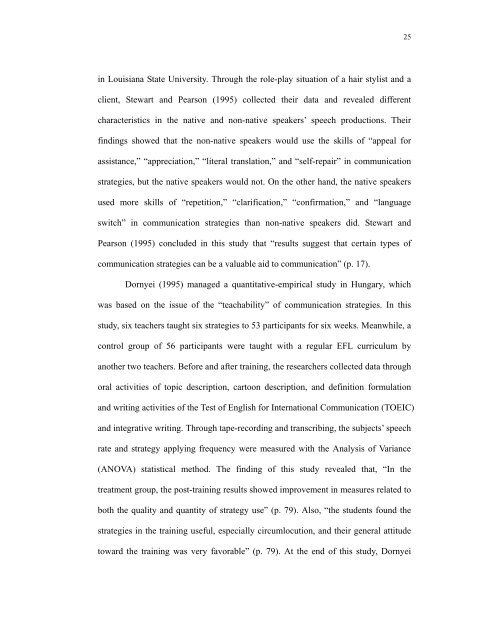A Dissertation by GRACE HUI-CHIN LIN Submitted to the Office of ...
A Dissertation by GRACE HUI-CHIN LIN Submitted to the Office of ...
A Dissertation by GRACE HUI-CHIN LIN Submitted to the Office of ...
Create successful ePaper yourself
Turn your PDF publications into a flip-book with our unique Google optimized e-Paper software.
in Louisiana State University. Through <strong>the</strong> role-play situation <strong>of</strong> a hair stylist and a<br />
client, Stewart and Pearson (1995) collected <strong>the</strong>ir data and revealed different<br />
characteristics in <strong>the</strong> native and non-native speakers’ speech productions. Their<br />
findings showed that <strong>the</strong> non-native speakers would use <strong>the</strong> skills <strong>of</strong> “appeal for<br />
assistance,” “appreciation,” “literal translation,” and “self-repair” in communication<br />
strategies, but <strong>the</strong> native speakers would not. On <strong>the</strong> o<strong>the</strong>r hand, <strong>the</strong> native speakers<br />
used more skills <strong>of</strong> “repetition,” “clarification,” “confirmation,” and “language<br />
switch” in communication strategies than non-native speakers did. Stewart and<br />
Pearson (1995) concluded in this study that “results suggest that certain types <strong>of</strong><br />
communication strategies can be a valuable aid <strong>to</strong> communication” (p. 17).<br />
Dornyei (1995) managed a quantitative-empirical study in Hungary, which<br />
was based on <strong>the</strong> issue <strong>of</strong> <strong>the</strong> “teachability” <strong>of</strong> communication strategies. In this<br />
study, six teachers taught six strategies <strong>to</strong> 53 participants for six weeks. Meanwhile, a<br />
control group <strong>of</strong> 56 participants were taught with a regular EFL curriculum <strong>by</strong><br />
ano<strong>the</strong>r two teachers. Before and after training, <strong>the</strong> researchers collected data through<br />
oral activities <strong>of</strong> <strong>to</strong>pic description, car<strong>to</strong>on description, and definition formulation<br />
and writing activities <strong>of</strong> <strong>the</strong> Test <strong>of</strong> English for International Communication (TOEIC)<br />
and integrative writing. Through tape-recording and transcribing, <strong>the</strong> subjects’ speech<br />
rate and strategy applying frequency were measured with <strong>the</strong> Analysis <strong>of</strong> Variance<br />
(ANOVA) statistical method. The finding <strong>of</strong> this study revealed that, “In <strong>the</strong><br />
treatment group, <strong>the</strong> post-training results showed improvement in measures related <strong>to</strong><br />
both <strong>the</strong> quality and quantity <strong>of</strong> strategy use” (p. 79). Also, “<strong>the</strong> students found <strong>the</strong><br />
strategies in <strong>the</strong> training useful, especially circumlocution, and <strong>the</strong>ir general attitude<br />
<strong>to</strong>ward <strong>the</strong> training was very favorable” (p. 79). At <strong>the</strong> end <strong>of</strong> this study, Dornyei<br />
25
















